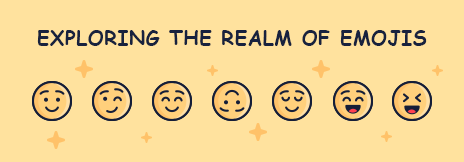What is the shortest definition of the word ‘happy’ you can come up with? Will it beat this little, inconspicuous image → ![]() ? Don’t think so! Not only is it the most concise and explicit description available, it is the most universal one as well – going far beyond any language or cultural barrier. It is because of this very economy of use and transparency of meaning that emojis have sneaked into our digital conversations almost overnight. Pressured by the increasingly hurried lifestyle, we simply needed to communicate more ideas and feelings in less time and space. And emojis – font-based representations of our basic facial expressions – seem to be doing this job just fine!
? Don’t think so! Not only is it the most concise and explicit description available, it is the most universal one as well – going far beyond any language or cultural barrier. It is because of this very economy of use and transparency of meaning that emojis have sneaked into our digital conversations almost overnight. Pressured by the increasingly hurried lifestyle, we simply needed to communicate more ideas and feelings in less time and space. And emojis – font-based representations of our basic facial expressions – seem to be doing this job just fine!
Benefits of adopting emoji communication techniques
Emojis are all the rage in today’s world. It was only a matter of time, then, before companies jumped at the whole sea of new opportunities these colorful icons presented. But what exactly is so compelling about these tiny symbols that hundreds of enterprises around the globe started to blend them into their everyday marketing strategies?
Our organism is programmed to thrive on social interaction. On the most basic level, emojis compensate for the lack of body language and emotions in digital communications, humanizing our online experience. In a broader perspective, they help to break the ice between people interacting in the cyber world by building a relaxed, anxiety-free atmosphere. One of the biggest problems with monitor-to-monitor rather than face-to-face conversation is that it can additionally widen the already existing language gaps. Do you sometimes feel like there is some miscommunication going on between you and the customers who are speaking a different language? Trust us, the feeling most probably is mutual. Through a simple use of emoticons you can help your recipients grasp the nuances of utterances more easily, avoid erroneous interpretations, and consequently, bring the business negotiations to a successful fruition. Lastly, emojis hold one crucial advantage over plain text – they involve an extra sense (vision) which fosters better memorization. So if you wish to make an everlasting impact on your audience – you have just found your golden ticket!

To use or not to use – the etiquette of emojis
How many times did you want to say one thing, but opted for something totally different in the end for the fear of embarrassment? When it comes to business sphere, emojis tend to cause similar mixed feelings, even despite their ubiquitous nature. Sometimes the line between what is professional and what longer appropriate seems so blurry, that as an entrepreneur you would rather remain in your comfort zone than risk a major PR faux pas. But it does not have to be that way.
With these few tips you will learn how to effectively recognize the right contexts for using emojis in business discussions and turn them into your strong suit.
1. Who is your audience?
When you send a ![]() or
or ![]() emoji to your colleagues, you may only hope they have a good sense of humor (or at least enough patience to bear with your complete lack of social graces). Never assume the same about a person outside your workplace circle. Before flooding your message with symbols, first scan whomever you are addressing. Is it a potential client or a partner? Focus on facts and details rather than pleasantries then for this is neither the time nor the place for textual ornaments. The only thing worse from sounding unprofessional is being treated as a jester. If, on the other hand, you are communicating with a long-lasting customer (or the one who uses symbols in his/her messages too), you can also loosen up the tone with one or two emojis.
emoji to your colleagues, you may only hope they have a good sense of humor (or at least enough patience to bear with your complete lack of social graces). Never assume the same about a person outside your workplace circle. Before flooding your message with symbols, first scan whomever you are addressing. Is it a potential client or a partner? Focus on facts and details rather than pleasantries then for this is neither the time nor the place for textual ornaments. The only thing worse from sounding unprofessional is being treated as a jester. If, on the other hand, you are communicating with a long-lasting customer (or the one who uses symbols in his/her messages too), you can also loosen up the tone with one or two emojis.
2. Probe the situation
You would not wear a tracksuit to a wedding party, would you? Smileys also may appear awkward (if not disrespectful) when inserted in the middle of a serious conversation. Whether you are securing an important business contract or passing on some sensitive information to a client, it is best to refrain from emojis completely. But what if your client boasts about having a new baby? How can you not press ![]() while congratulating them on this great news? Feeling your way through the situation is the key to success.
while congratulating them on this great news? Feeling your way through the situation is the key to success.
3. Know your emojis
With hundreds of similarly-looking symbols, it is easier to send your recipient a mixed message than you might think. Take a look at this emoji: ![]() . What a cool peace sign, isn’t it? Not exactly. Quite many people in fact are oblivious to its true meaning which is ‘V’ for ‘victory’. If you are not 100% sure whether the given icon fits in the particular context, better leave it alone. Express your idea with plain words instead, or use very basic emojis which leave no room for misinterpretation.
. What a cool peace sign, isn’t it? Not exactly. Quite many people in fact are oblivious to its true meaning which is ‘V’ for ‘victory’. If you are not 100% sure whether the given icon fits in the particular context, better leave it alone. Express your idea with plain words instead, or use very basic emojis which leave no room for misinterpretation.
4. Focus on the positive
There are two types of emotions which human beings find almost impossible to hold back – happiness and anger. While your customers are entitled to expressing both, you on the other hand need to be more selective. To the extent where you reduce negative emojis to the absolute minimum. Having a rough day? Unsatisfied with your customer’s behavior? Learn to keep your nerves under control. Excessive use of such emojis as ![]() or
or ![]() may cause your customers feel intimidated, or worse – only add fuel to the fire. Showing understanding and forgiveness rather than reprimanding is definitely more rewarding.
may cause your customers feel intimidated, or worse – only add fuel to the fire. Showing understanding and forgiveness rather than reprimanding is definitely more rewarding.
5. Do not go overboard
Let us assume you have already tested the waters and decided it is safe to put the emoji symbol in your online conversation. But before you do, bear with us a little longer and take this one final tip. There is only one step separating you from sounding like a friendly businessman and an overly emotional teenager. And this step is moderation. Do not let emojis become your trademark – using them once in a while is an acceptable frequency, but deploying them on a regular basis (every day, every client, every message) is a big no-no.
Emojis have turned into such a widespread phenomenon that trying to resist their charm (and potential!) is simply futile. We are positive that by following our five golden rules of emoji etiquette, these lovely symbols will add much valor to your business discourse and help you build long-lasting relationships with your clientele.
And how important are emojis to you in business communication? Share your viewpoint by voting in the comments below! Use the 1-5 rating scale, where 1 marks means ‘rather unnecessary’ and 5 means ‘very useful’.
Lastly, we have great news for all emoji enthusiasts! Up until 22nd July you can save as much as 25% on the purchase of our Emoji Picker For WHMCS module. In order to seize this extraordinary opportunity, simply apply the special promo code available on our website!
Put on a smile! ,



Yes,emoji is very important in business communication. When I talk with my customers, I will use emoji. At this time,all things get better. I found teenagers are more easy on accepting the emojis.
Thank you, it is amazing to know you share our enthusiasm on this subject!
So, would you give a strong ’5′ when it comes to the importance of emojis in business?
I give 5. There was time when my client often wrote emojis but I was not sure to use them back. Things change now. I use them more and think my clients feel relaxed, because of this.
Many thanks for your feedback, Jon! I am certain with time you will feel utterly confident about using emojis in conversations with your clients. As they say – practice makes perfect!
Hi,
Are you guys really being serious? I am by the way not being judgemental, I am genuinely asking if it’s appopriate to use emoji’s during things like tickets?. Is it really a positive outcome. I have seen the addon but, what did put me off was when it started taking puny-code domains and create some gibberish with them.
Honestly, I can understand the emoji’s and I use them such as : ) no space, but I just was more afraid that the clients might feel as if we’re not a serious company, like a MAD MAGAZINE.
Your sincere opinion on this matter is truly appreciated, Steini. We perfectly understand that using emojis in professional contexts is still quite controversial to many people. And hey, that is what we are trying to convey in our article in the first place! Sure, emojis are becoming more and more widespread, but as we already mentioned – moderation is the key concept here. There are some limitations that must be taken into account. And instead of compelling anyone to switch to this method of communication, we simply wanted to provide all those hooked up on the topic of emojis with some useful, practical tips. Hope it worked well.
Sure, emojis are becoming more and more widespread, but as we already mentioned – moderation is the key concept here. There are some limitations that must be taken into account. And instead of compelling anyone to switch to this method of communication, we simply wanted to provide all those hooked up on the topic of emojis with some useful, practical tips. Hope it worked well. 